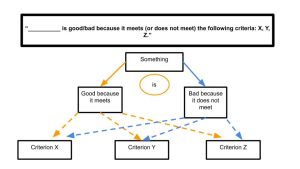12
Key Concept
Evaluative Argument: argues that a condition is good/bad, effective/ineffective, helpful/harmful, etc.

In our chapter on definition arguments, we discussed how to make an argument that defines a certain condition. For instance, a definition argument can be used to define the amount of national student loan debt as a “crisis” by looking at the criteria for what makes something a “crisis” and then exploring how the situation with student loan debt meets those criteria. Equally, a definition argument can be used to define the actions of an athlete who kneels during the National Anthem to be “patriotic” (or “unpatriotic” depending on your point of view) by looking at the criteria for what makes something “patriotic” or “unpatriotic” and then considering how kneeling during the National Anthem fits into those criteria.
In this chapter, we’ll discuss evaluative arguments, which also seek to examine how a certain condition aligns with (or doesn’t align with) a specific set of criteria. What makes evaluative arguments different from definition arguments, however, is that evaluative arguments seek to attach a value judgement to something–they seek to evaluate it.
For our purposes, there are three sets of criteria we’ll be discussing that we can use to make evaluative arguments:
- Practical: Does the thing being evaluated achieve the practical purpose it sets out to achieve?
- Aesthetic: Does the thing being evaluated successfully adhere to a set of artistic standards?
- Ethical: Does the thing being evaluated successfully adhere to a set of ethical standards?
When we’re evaluating something, it’s important to identify which set of criteria we’re holding it to. Equally, it’s useful to note that sometimes these criteria can work against each other. For example, a disposable plastic drinking straw may easily be evaluated as “good” by meeting a set of practical criteria: it provides a cheap, accessible, sanitary way for consumers to drink beverages. However, that same drinking straw could just as easily be evaluated as “bad” by a set of ethical criteria: these same straws end up in landfills, take decades to breakdown, and negatively impact wildlife on land and sea. Equally, say the same disposable drinking straw is green and that it matches the color of the logo of a chain of coffee shops that’s looking for a straw supplier; that same drinking straw, then, could be evaluated as “good” by a set of aesthetic criteria (and practical criteria as well). Indeed, different evaluative criteria can serve very different purposes, so it will be important for us to think about how we are evaluating something and which criteria we’re using.
When we’re selecting the criteria that we’ll be basing our evaluative arguments on, it’s critical that we consider our audience and the set (or sets) of criteria that they value. Consider the above example about plastic drinking straws. If our audience is likely to perceive the situation by a set of ethical criteria, then they are more likely to be persuaded by the negative ethical evaluation (i.e. that disposable plastic drinking straws are bad because they damage the environment). Or if our audience is likely to perceive the situation by a set of practical criteria (perhaps they want the straw that is cheapest) then they are more likely to be persuaded by an evaluative argument that’s based on practical criteria. Again, here, as always, thinking about audience is a crucial step in the process of persuasion.
For our purposes, however, here is how we can think about making evaluative arguments:
- Identify a controversy in your topic that involves deciding if something is effective or ineffective, good or bad, etc.
- Create a thesis that takes a position on the issue by:
- identifying the category of evaluation
- developing the criteria that compose that category
- seeing if the case you are studying does or does not meet the criteria
Recapping the main ideas behind Evaluative Arguments:
- Evaluative arguments argue that something is good/bad, effective/ineffective, helpful/harmful, etc.
- They evaluate something based one of the follow three types of criteria: practical, aesthetic, ethical.
- They consider which set of criteria (practical, aesthetic, ethical) their audience is likely to be convinced by.
